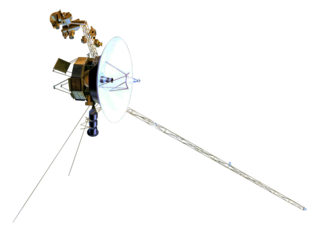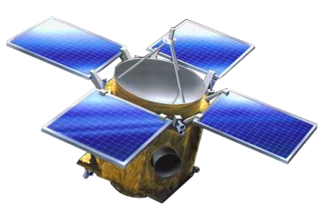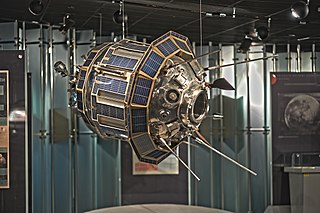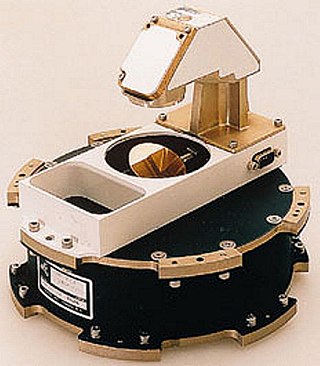Related Research Articles

Deep Space 1 (DS1) was a NASA technology demonstration spacecraft which flew by an asteroid and a comet. It was part of the New Millennium Program, dedicated to testing advanced technologies.

Spacecraft propulsion is any method used to accelerate spacecraft and artificial satellites. In-space propulsion exclusively deals with propulsion systems used in the vacuum of space and should not be confused with space launch or atmospheric entry.

Voyager 2 is a space probe launched by NASA on August 20, 1977, to study the outer planets and interstellar space beyond the Sun's heliosphere. As a part of the Voyager program, it was launched 16 days before its twin, Voyager 1, on a trajectory that took longer to reach gas giants Jupiter and Saturn but enabled further encounters with ice giants Uranus and Neptune. Voyager 2 remains the only spacecraft to have visited either of the ice giant planets. Voyager 2 was the third of five spacecraft to achieve Solar escape velocity, which allowed it to leave the Solar System.

Near Earth Asteroid Rendezvous – Shoemaker, renamed after its 1996 launch in honor of planetary scientist Eugene Shoemaker, was a robotic space probe designed by the Johns Hopkins University Applied Physics Laboratory for NASA to study the near-Earth asteroid Eros from close orbit over a period of a year. It was the first spacecraft to orbit an asteroid and land on it successfully. In February 2000, the mission closed in on the asteroid and orbited it. On February 12, 2001, Shoemaker touched down on the asteroid and was terminated just over two weeks later.

Ulysses was a robotic space probe whose primary mission was to orbit the Sun and study it at all latitudes. It was launched in 1990 and made three "fast latitude scans" of the Sun in 1994/1995, 2000/2001, and 2007/2008. In addition, the probe studied several comets. Ulysses was a joint venture of the European Space Agency (ESA) and the United States' National Aeronautics and Space Administration (NASA), under leadership of ESA with participation from Canada's National Research Council. The last day for mission operations on Ulysses was 30 June 2009.

Luna 3, or E-2A No.1 was a Soviet spacecraft launched in 1959 as part of the Luna programme. It was the first mission to photograph the far side of the Moon and the third Soviet space probe to be sent to the neighborhood of the Moon. Though it returned rather poor pictures, the historic, never-before-seen views of the far side of the Moon caused excitement and interest when they were published around the world, and a tentative Atlas of the Far Side of the Moon was created after image processing improved the pictures.

A reaction wheel (RW) is used primarily by spacecraft for three-axis attitude control, and does not require rockets or external applicators of torque. They provide a high pointing accuracy, and are particularly useful when the spacecraft must be rotated by very small amounts, such as keeping a telescope pointed at a star.

The Magellan spacecraft was a 1,035-kilogram (2,282 lb) robotic space probe launched by NASA of the United States, on May 4, 1989, to map the surface of Venus by using synthetic-aperture radar and to measure the planetary gravitational field.

The attitude indicator (AI), formerly known as the gyro horizon or artificial horizon, is a flight instrument that informs the pilot of the aircraft orientation relative to Earth's horizon, and gives an immediate indication of the smallest orientation change. The miniature aircraft and horizon bar mimic the relationship of the aircraft relative to the actual horizon. It is a primary instrument for flight in instrument meteorological conditions.

A CubeSat is a class of miniaturized satellite based around a form factor consisting of 10 cm (3.9 in) cubes. CubeSats have a mass of no more than 2 kg (4.4 lb) per unit, and often use commercial off-the-shelf (COTS) components for their electronics and structure. CubeSats are put into orbit by deployers on the International Space Station, or launched as secondary payloads on a launch vehicle. As of August 2021, more than 1,600 CubeSats have been launched.
In astrodynamics, orbital station-keeping is keeping a spacecraft at a fixed distance from another spacecraft or celestial body. It requires a series of orbital maneuvers made with thruster burns to keep the active craft in the same orbit as its target. For many low Earth orbit satellites, the effects of non-Keplerian forces, i.e. the deviations of the gravitational force of the Earth from that of a homogeneous sphere, gravitational forces from Sun/Moon, solar radiation pressure and air drag, must be counteracted.

A reaction control system (RCS) is a spacecraft system that uses thrusters to provide attitude control and translation. Alternatively, reaction wheels are used for attitude control. Use of diverted engine thrust to provide stable attitude control of a short-or-vertical takeoff and landing aircraft below conventional winged flight speeds, such as with the Harrier "jump jet", may also be referred to as a reaction control system.
The design of spacecraft covers a broad area, including the design of both robotic spacecraft, and spacecraft for human spaceflight.
In aerospace engineering, spin stabilization is a method of stabilizing a satellite or launch vehicle by means of spin, i.e. rotation along the longitudinal axis. The concept originates from conservation of angular momentum as applied to ballistics, where the spin is commonly obtained by means of rifling. For most satellite applications this approach has been superseded by three-axis stabilization.

ATS-6 was a NASA experimental satellite, built by Fairchild Space and Electronics Division It has been called the world's first educational satellite as well as world's first experimental Direct Broadcast Satellite as part of the Satellite Instructional Television Experiment between NASA and Indian Space Research Organisation (ISRO). It was launched May 30, 1974, and decommissioned July 1979. At the time of launch, it was the most powerful telecommunication satellite in orbit. ATS-6 carried no fewer than 23 different experiments, and introduced several breakthroughs. It was the first 3-axis stabilized spacecraft in geostationary orbit. It was also the first to use experimentally with some success electric propulsion in geostationary orbit. It also carried several particle physics experiments, including the first heavy ion detector in geostationary orbit.
The Intelsat VI series of satellites were the 8th generation of geostationary communications satellites for the Intelsat Corporation. Designed and built by Hughes Aircraft Company (HAC) in 1983-1991, there were five VI-series satellites built: 601, 602, 603, 604, and 605.
Spacecraft attitude control is the process of controlling the orientation of a spacecraft with respect to an inertial frame of reference or another entity such as the celestial sphere, certain fields, and nearby objects, etc.

CubeSat for Solar Particles (CuSP) was a low-cost 6U CubeSat to orbit the Sun to study the dynamic particles and magnetic fields. The principal investigator for CuSP is Mihir Desai, at the Southwest Research Institute (SwRI) in San Antonio, Texas. It was launched on the maiden flight of the Space Launch System (SLS), as a secondary payload of the Artemis 1 mission on 16 November 2022.
NASA's Pathfinder Technology Demonstrator (PTD) Project will test the operation of a variety of novel technologies on a type of nanosatellites known as CubeSats, providing significant enhancements to the performance of these versatile spacecraft. Each of the five planned PTD missions consist of a 6-unit (6U) CubeSat with expandable solar arrays.

Galileo was an American robotic space probe that studied the planet Jupiter and its moons, as well as the asteroids Gaspra and Ida. Named after the Italian astronomer Galileo Galilei, it consisted of an orbiter and an entry probe. It was delivered into Earth orbit on October 18, 1989, by Space ShuttleAtlantis , during STS-34. Galileo arrived at Jupiter on December 7, 1995, after gravitational assist flybys of Venus and Earth, and became the first spacecraft to orbit an outer planet.
References
- ↑ "PIA14805: A Sideways Glance". Jet Propulsion Laboratory. Retrieved 2012-01-01.
- ↑ "Tycho Central Peak Spectacular!". NASA's Lunar Science Institute. Retrieved 2012-01-01.
- ↑ "GCN GRB Observation Report". NASA's Goddard Space Flight Center. Retrieved 2012-01-01.
- ↑ "Basics of Space Flight: Section II". Jet Propulsion Laboratory. Retrieved 2012-01-01.
- ↑ "Dictionary of Technical Terms for Space". NASA's Software, Robotics and Simulation Division. Retrieved 2012-01-01.